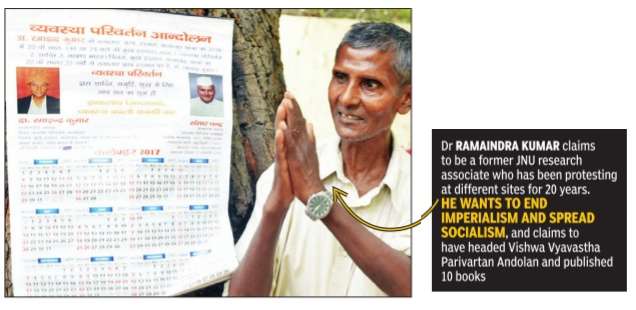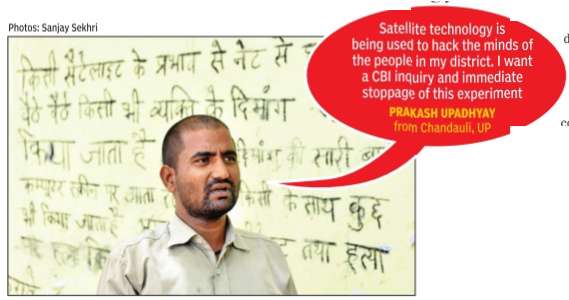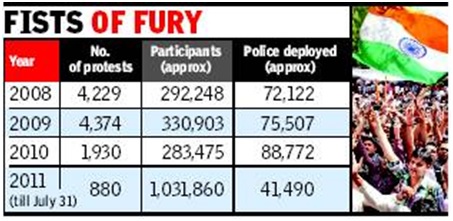Delhi: Political protests
(→Jantar Mantar) |
(→The issues that people protest about) |
||
| Line 30: | Line 30: | ||
People from every corner of the country could be seen here through out the year, raising different issues. “I have been posted here at Parliament Street police station for the past two-and-a-half years. I everyday see people coming from different places. Somebody has an individual problem of his department not giving him his dues, someone wants to root out corruption from the country or someone else may be fighting cruelty against animals. Some of them stay here for several months,” said a cop. | People from every corner of the country could be seen here through out the year, raising different issues. “I have been posted here at Parliament Street police station for the past two-and-a-half years. I everyday see people coming from different places. Somebody has an individual problem of his department not giving him his dues, someone wants to root out corruption from the country or someone else may be fighting cruelty against animals. Some of them stay here for several months,” said a cop. | ||
| − | + | =The issues that people protest about= | |
| + | ==1== | ||
[http://epaperbeta.timesofindia.com/Article.aspx?eid=31808&articlexml=From-basic-to-bizarre-at-Delhis-protest-bazaar-12052017004018 Paras Singh, From basic to bizarre at Delhi's protest bazaar, May 12, 2017: The Times of India] | [http://epaperbeta.timesofindia.com/Article.aspx?eid=31808&articlexml=From-basic-to-bizarre-at-Delhis-protest-bazaar-12052017004018 Paras Singh, From basic to bizarre at Delhi's protest bazaar, May 12, 2017: The Times of India] | ||
[[File: SK Pandit protesting in Jantar Mantar, Delhi.jpg|SK Pandit protesting in Jantar Mantar, Delhi; [http://epaperbeta.timesofindia.com/Article.aspx?eid=31808&articlexml=From-basic-to-bizarre-at-Delhis-protest-bazaar-12052017004018 Paras Singh, From basic to bizarre at Delhi's protest bazaar, May 12, 2017: The Times of India]|frame|500px]] | [[File: SK Pandit protesting in Jantar Mantar, Delhi.jpg|SK Pandit protesting in Jantar Mantar, Delhi; [http://epaperbeta.timesofindia.com/Article.aspx?eid=31808&articlexml=From-basic-to-bizarre-at-Delhis-protest-bazaar-12052017004018 Paras Singh, From basic to bizarre at Delhi's protest bazaar, May 12, 2017: The Times of India]|frame|500px]] | ||
Revision as of 15:45, 7 October 2017
This is a collection of articles archived for the excellence of their content. |
Jantar Mantar
Neeraj Chauhan TNN
The Times of India, Aug 8, 2011
Delhi Police claims there could be law and order problems if it allows the Gandhian crusader against corruption to sit on an indefinite hunger strike at Jantar Mantar along with thousands of his followers for more than a day or two.
But according to Delhi Police itself, on an average, over 2,000 demonstrations, dharnas and rallies involving three to five lakh people are held here every year and over 80,000 security personnel get deployed to manage them. Very few of these protests turn violent, most go on silently for months, some even for years.
The rebirth of this astronomical observatory of the 18th century as the breeding ground of protests occurred in 1993 when the Narasimha Rao government banned such activities at the Boat Club. Since then, it has been witness to every major and minor protest in the capital, including the AIIMS agitation, farmers’ protest and Hazare’s first phase of campaign against corruption.
On an average, 10 to 15 rallies/protests take place daily and police arrangements are always in place. The number of personnel varies though, depending on the need of the situation. Delhi Police says that till July 31 this year, 880 protests have taken place at Jantar Mantar and the nearby areas.
While 1,031,860 people have participated in them, 41,940 officers have been deployed for these protests marked under different categories — demonstrations (570), rallies (37), dharnas (216) and strikes/ hunger strikes (57). Officials say this year’s figure has been the highest in the past few years because of Hazare’s previous campaign.
People from every corner of the country could be seen here through out the year, raising different issues. “I have been posted here at Parliament Street police station for the past two-and-a-half years. I everyday see people coming from different places. Somebody has an individual problem of his department not giving him his dues, someone wants to root out corruption from the country or someone else may be fighting cruelty against animals. Some of them stay here for several months,” said a cop.
The issues that people protest about
1
Paras Singh, From basic to bizarre at Delhi's protest bazaar, May 12, 2017: The Times of India




Jantar Mantar has been the city's default agitation venue, with people sitting on stir for months on end for issues ranging from military pensions to jailed godmen
The national flag in his tight grip, 32-yr-old Abdul Gaffur Toofani scoffs at the 42 degree Celsius heat. His passion is hotter: he wants terrorism disassociated from Islam. It is a legitimate demand, but did he have to come all the way from Araria in Bihar to this leafy stretch in Delhi to say so?
“Yes, because here we get heard,“ he responds unequivocally.
Indeed, it is at this site, called “Mini India“ by historian Ramachandra Guha, that people from across the country gather hoping to be heard. Abutting the medieval astronomical laboratory of Jantar Mantar, scoffers would dismiss the disparate demands being made as pies in the skies. Indeed, it would appear so when there are people like Prakash Upadhyay, 30, from Chandauli, protesting against “satellite technology being used to hack people's minds in my district“ and Dattatreya Mohan, 47, demanding Rs 4,300 crore plus interest that the government “owes him after the British government illegally occupied my 1.7-acre land in Sangli in 1881 for railway use“.
But as David Raj, 27, who wants the 7,000 liquor shops in Delhi shut down, pointed out, “This is a perfect place to get the government's attention because of its nearness to Parliament.“ No wonder so many have lingered on trying to catch the government's attention. Eleven ex-servicemen recorded the 696th day of their relay hunger strike for one-rank-one-pension on Wednesday . The followers of Asaram Bapu and Rampal have spent 1,354 and 601 days, respectively, at Jantar Mantar, trying to persuade the authorities to free their jailed spiritual gurus.
On Tuesday, the National Green Tribunal asked Delhi government why it had not explored an alternative site for the disgruntled democrats to exercise their right to protest. Justice Swatanter Kumar, NGT chairperson, wondered why Delhi's version of Speakers' Corner in Lon don's Hyde P a r k could not be located at more convenient places such as Ramlila Maidan. Indeed, the 200-metre span of the neem-tree-lined Jantar Mantar Road is overstretched.Parliament Street police station receives 24,000 requests for permission to hold protests every year. The thousands congregating there -“Some people have been living here for years; we removed around 40 tents of such protestors in the past few weeks,“ said the area SHO -has only created its own economy, but has placed a big strain on civic amenities. After the infamous capture by farmers of the original protest spot at Boat Club near India Gate in 1988, the government shifted the theatre of protests to Jantar Mantar.Since then, eight small eateries, a dozen tea services and even a couple of barbers have set up businesses to meet the needs of discontented Indians.
Hygiene, however, is a barely addressed necessity. A grossly overused public restroom and a few here-today-gone-tomorrow mobile toilets force most to do the best they can when nature calls. Bangla Sahib Gurdwara in the vicinity is generous with both food and toilets, but it cannot cater to the teeming crowds.
“There is filth all around,“ grumbled Varun Seth, whose bungalow is located on the stretch.Besides the disgust of open defecation, the residents have to suffer constant cacophony and jammed lanes. Seth is one of those who petitioned the National Green Tribunal to get the protestors moved to another location. The Dhawandeep Society RWA too has approached Delhi high court on the matter.
But to the myriad protestors these don't matter. Ask them if anyone has ever heard their slogans, and there are affirmative nods.“You did, didn't you?“ quipped one of them. And that is inspiration enough for the genuinely disaffected as well as the mavericks at Jantar Mantar as they bid to challenge the Establishment.
